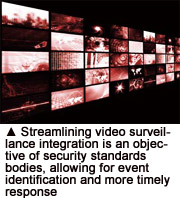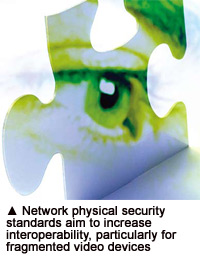As different network video standards emerge, they have individual strengths and weaknesses. Ajit Dubey, Senior Project Manager of the Embedded System Group at eInfochips, examines the differences.
As different network video standards emerge, they have individual strengths and weaknesses. Ajit Dubey, Senior Project Manager of the Embedded System Group at eInfochips, examines the differences.
According to
IPVideoMarket.info, IP video surveillance product sales are forecast to increase by 200 percent between 2010 and 2012. Total market revenue is expected to reach US$6.48 billion in 2012, according to the Frost & Sullivan report, "World Internet Protocol Surveillance Markets." IMS Research reported the video surveillance market will reach $4 billion by 2011.
Several driving factors for this growth include more low-cost HD cameras with 720 horizontal scan lines or 1.3-megapixel resolution. For storage, hybrid DVRs and NVRs remove barriers for legacy deployments to migrate to IP. Finally, maturing network camera standards and protocols will reduce the cost and complexity of IP video surveillance.
While IP provides the benefits of connectivity, wider uptake faces a number of challenges. Manufacturers have a selection of video coding standards, which each have different profiles. There is more fragmentation in streaming protocols, storage formats and video analytics. Configuring PTZ functionality is also difficult between third-party video devices. Interoperability is a key challenge for security professionals managing PTZ, network configuration and legacy compatibility.
Development in IP surveillance is driven by quality of service and bandwidth usage. H.264 provides high compression, utilizing less bandwidth. By comparison, M-JPEG, MPEG-4 and MPEG-2 consume more bandwidth for the same quality.
Cameras, DVRs and NVRs support the RTP/RTSP and HTTPS protocols, which are prevalent in the market. Some legal systems prohibit the storage of audio for privacy or confidential reasons. This adds another flavor to the system. Devices supporting only video can store elementary streams as is, while devices supporting audio, video and metadata require containers like MP4, MOV, 3GP, AVI and MPEG-2-TS.
The advent of video analytics enhances the storage capability of video systems supporting conditional storage along with generating alarms. More than 20 PTZ protocols are available worldwide by various camera manufacturers.
Standard Specifications
Growth opportunities in the surveillance market have driven demand for open standards for interoperability. With companies realizing that delivering network camera standards is important for expanding and maturing the IP video surveillance market, it has led to the formation of two bodies — the
Open Network Video Interface Forum (ONVIF) and the
Physical Security Interoperability Alliance (PSIA).

PSIA and ONVIF were formed in 2008 just a few months apart to create standards-based interfaces for physical security hardware and software platforms. They are two groups pursuing the same fundamental goal of bringing interoperability to IP-based security systems. The ONVIF group is led by Axis Communications, Sony Corporation and Bosch Security Sytems, demonstrating 14 interoperable network video products from nine companies so far. Its membership has grown to 103 companies, with 12 full members, 13 contributing members and 78 user members. ONVIF released its first draft of specifications in November 2008.
PSIA is a global consortium of more than 50 physical security manufacturers and system integrators. In September 2008, it had a specification out for public review and now eight companies have interoperable products
ONVIF and PSIA Comparison
IMS Research said in a July 2009 report, "ONVIF member companies command over 40 percent of worldwide video surveillance market revenues compared with the 25 percent taken by PSIA member companies. The difference is even more startling when put into the context of network video surveillance equipment. Here ONVIF member companies command nearly 60 percent of market revenues compared with the 20 percent share for PSIA member companies."
Manufacturers and integrators seem to be suffering from indecision when the two groups promote their respective specifications.
ONVIF seems to be focused on IP video, particularly cameras and analytics. The main focus is interface between a network video transmitter (NVT) and a network video client (NVC). The specification covers device discovery, device configuration, events, PTZ control, video analytics and real-time streaming functions
PSIA has defined specifications, which are more general for the broader physical security market. This includes access control, storage and more, rather than just IP video.
The following are a few technology differences between ONVIF and PSIA, which may drive the adoption of standards in the IP surveillance market.
1. The ONVIF specification framework is built upon Web service standards. Web service is the standardized method of integrating applications using open-platform independent standards such as XML, Simple Object Access Protocol (SOAP, SOAP 1.2, Part 1) and WSDL (WSDL1.1) over an IP network. XML is used as the data description syntax, SOAP is used for message transfer and WSDL is used for describing the services. SOAP is an XML-based messaging protocol used to encode the information in a Web service request and in a response message

before sending the information over a network. SOAP is considered to be complex as well as rigid for implementation.
On the other side, PSIA uses representational state transfer (REST) architecture. REST is the latest favored approach, as almost all Web services are using it today. REST is simple to use compared to SOAP and only requires a simple XML parser with less processing, resulting in fewer resources. The REST architecture requires less overhead than SOAP. REST has another advantage of human readable protocol messages, which are easy to integrate for debugging the system. Due to its additional overhead, SOAP has major disadvantages, both in terms of computing power and required bandwidth.
SOAP requires a fully compliant HTTP server, SSL and a fully compliant XML parser.
For example, to change PTZ position in ONVIF, it requires a SOAP header declaration of approximately 12 KB, which is redundant, to be sent for each message. For PSIA, changing PTZ position requires visiting a URL link, which needs relatively few bytes in comparison.
2. ONVIF network detection makes use of Microsoft-centric technology (WS Discovery) for its device discovery mechanism. This hints that all ONVIF-compliant devices must implement the WS Discovery method. Since ONVIF-compliant products will always support WS Discovery, ONVIF provides 100-percent interoperability between ONVIF-compliant products as far as device discovery is concerned.
PSIA, on the other hand, provides multiple mechanisms like Zeroconf, UPnP and Bonjour for device discovery. While PSIA provides more flexibility to adopt mechanisms for device discovery, it also introduces complexity in interoperability for connecting PSIA-compliant products. For example, a PSIA-compliant camera supporting Bonjour cannot be connected with a PSIA-compliant video management system supporting UPnP, despite both the camera and video management system being PSIA-compliant.
3. ONVIF's event notification is based on the WS-Notify framework. These specifications dictate how a camera should notify events to higher layers, compared to PSIA's generalized message format for events and notifications. This again does not provide 100 percent interoperability for PSIA specifications compared to ONVIF specifications.
4. PSIA provides an easy interface for analytics integration compared to rigid ONVIF specifications.
5. Due to its REST-based architecture, PSIA's implementation is lightweight compared to ONVIF's SOAP-based architecture implementation.
6. PSIA has already defined specifications for media recording and storage, while

ONVIF is yet to define specifications for storage. This may be included in its future specification versions.
7. Since PSIA specifications focuses on broader aspects of physical security, PSIA also provides specifications for physical security information management (PSIM) integration.
Specifying Standards
Though the battle for network camera standardization continues between ONVIF and PSIA, a close look shows both standards are fairly similar. Both offer common capabilities to manage and control devices to provide interoperability among various products. Each specification provides mechanisms and guidelines to discover and manage devices, network configuration, analytics, PTZ configuration, streaming over HTTP/RTSP and security.
Companies can adopt the ONVIF standard for high-end video devices with analytics and camera configurations.
Companies with the need to control devices for PTZ, along with other services like storage and PSIM, can adopt PSIA. As the PSIA standard is based on REST, it is more appropriate for other areas of the physical security industry.
The structural model is not markedly different between the standards. As network camera specifications are more like logical specifications rather than physical ones, it will not be a surprise if camera manufacturers adopt both standards or the standards are merged to form a common one. For example, Cisco and Milestone support both standards for their products. eInfochips also plans to support both standards in its implementations of video management software, cameras and DVRs/NVRs.
Common network camera standardization will speed up integration efforts and compatibility between components from multiple vendors. This will reduce the overall cost of surveillance solutions.